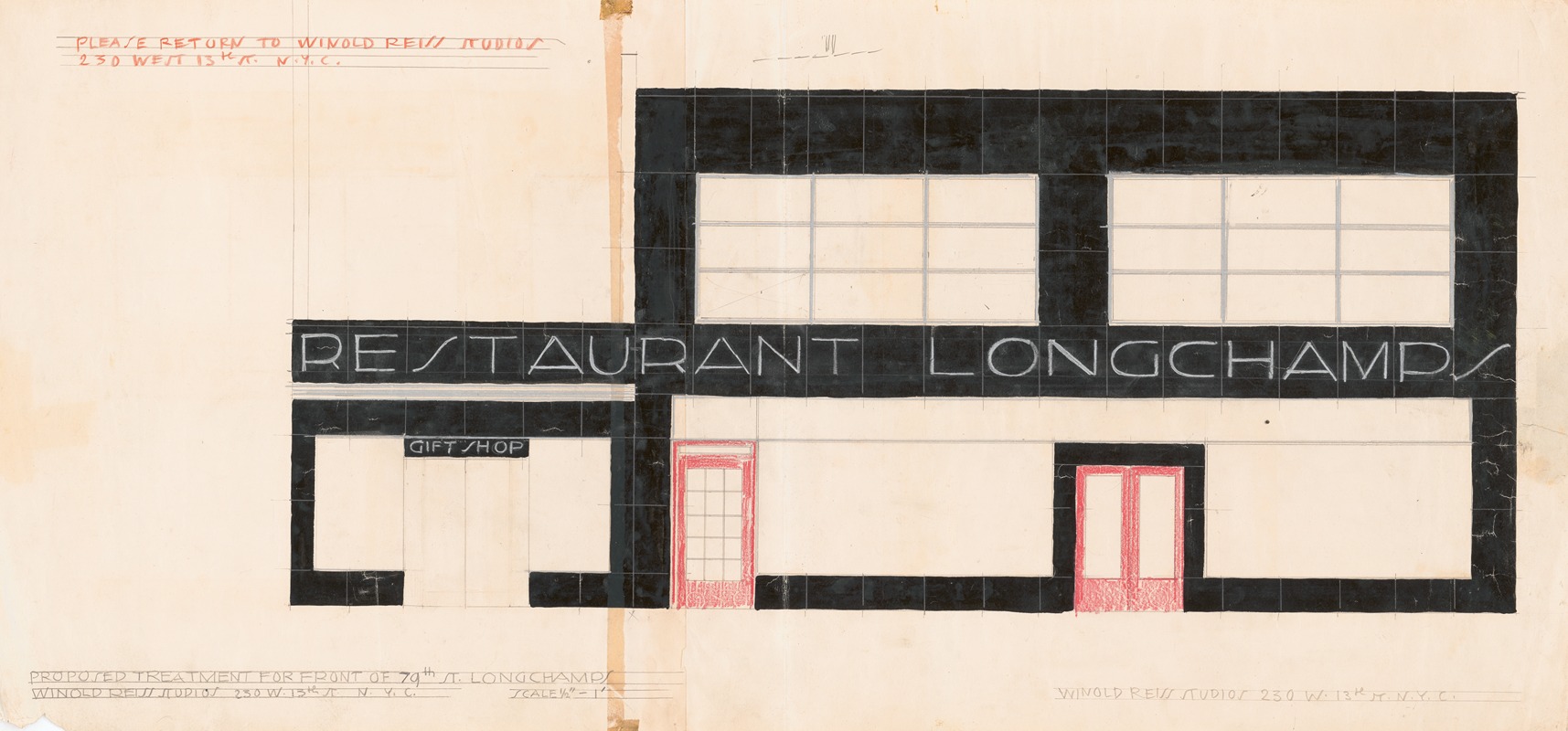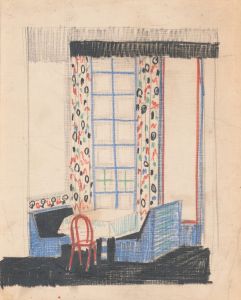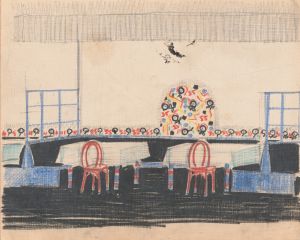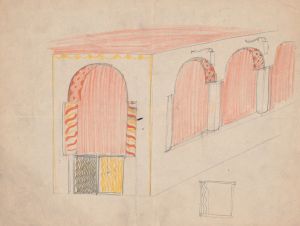
Design for Longchamps Restaurant, 79th St., New York, NY.] [Proposed treatment for front of restaurant
A hand-painted replica of Winold Reiss’s masterpiece Design for Longchamps Restaurant, 79th St., New York, NY.] [Proposed treatment for front of restaurant, meticulously crafted by professional artists to capture the true essence of the original. Each piece is created with museum-quality canvas and rare mineral pigments, carefully painted by experienced artists with delicate brushstrokes and rich, layered colors to perfectly recreate the texture of the original artwork. Unlike machine-printed reproductions, this hand-painted version brings the painting to life, infused with the artist’s emotions and skill in every stroke. Whether for personal collection or home decoration, it instantly elevates the artistic atmosphere of any space.
Winold Reiss (1886-1953) was a German-American artist and designer known for his vibrant and innovative contributions to American art and design in the early 20th century. One of his notable projects was the proposed treatment for the front of Longchamps Restaurant located at 79th Street in New York City. This design is a testament to Reiss's unique style and his ability to blend European modernist aesthetics with American commercial architecture.
Reiss was born in Karlsruhe, Germany, and trained at the Royal Academy of Fine Arts in Munich. He immigrated to the United States in 1913, where he quickly established himself as a prominent figure in the New York art scene. His work spanned various mediums, including painting, graphic design, and interior decoration. Reiss is particularly remembered for his portraits of Native Americans and African Americans, as well as his contributions to the Harlem Renaissance.
The Longchamps Restaurant chain was a popular dining establishment in New York City during the early to mid-20th century. Known for its Art Deco interiors and stylish ambiance, Longchamps was a favored spot for both locals and tourists. The chain was founded by Henry Lustig in the 1910s and expanded to several locations throughout the city.
Reiss's design for the Longchamps Restaurant at 79th Street exemplifies his skill in creating visually striking and culturally resonant spaces. The proposed treatment for the front of the restaurant featured bold geometric patterns, vibrant colors, and intricate detailing, all hallmarks of Reiss's design philosophy. His work often incorporated elements of Cubism and Art Deco, reflecting his European roots and his adaptation to the American cultural landscape.
The design aimed to create an inviting and modern facade that would attract patrons and enhance the restaurant's reputation as a chic and sophisticated dining destination. Reiss's use of color and form was intended to catch the eye of passersby and create a sense of excitement and elegance. The proposed treatment likely included decorative elements such as mosaics, murals, and custom-designed signage, all of which were common features in Reiss's commercial projects.
While specific details about the implementation of Reiss's design for the Longchamps Restaurant at 79th Street are limited, his influence on the overall aesthetic of the chain is well-documented. Reiss's work contributed to the distinctive look and feel of Longchamps, helping to establish it as a notable example of early 20th-century American restaurant design.
Winold Reiss's legacy as an artist and designer is significant, and his contributions to American art and architecture continue to be celebrated. His work on projects like the Longchamps Restaurant demonstrates his ability to blend artistic innovation with commercial functionality, creating spaces that were both beautiful and practical. Reiss's designs remain an important part of the history of American interior design and serve as a reminder of the rich cultural exchanges that have shaped the country's artistic heritage.





![Design drawing for a restaurant , Washington, D.C.] [Interior perspective of arcade and stage](/imgs/249272/s/winold-reiss-design-drawing-for-a-restaurant-washington-dc-interior-perspective-of-arcade-and-stage-55cc2361.jpg)
![Design for unidentified restaurant, possibly Dunhall’s Restaurant, New York, NY.] [Mural of masks and dancing figures](/imgs/249302/s/winold-reiss-design-for-unidentified-restaurant-possibly-dunhalls-restaurant-new-york-ny-mural-of-masks-and-dancing-figures-2b52066c.jpg)
![Design proposals for Puck Theater, New York, NY.] [Interior perspective study](/imgs/249305/s/winold-reiss-design-proposals-for-puck-theater-new-york-ny-interior-perspective-study-616c8d27.jpg)
![Designs for the Puck Theater , New York, NY.] [Exterior perspective study.](/imgs/249326/s/winold-reiss-designs-for-the-puck-theater-new-york-ny-exterior-perspective-study-8f47d02.jpg)
![Designs for unidentified restaurant interior, possibly Elysée restaurant, 1 East 56th St., New York, NY.] [Drawing of restaurant interior elevations](/imgs/249334/s/winold-reiss-designs-for-unidentified-restaurant-interior-possibly-elysee-restaurant-1-east-56th-st-new-york-ny-drawing-of-restaurant-interior-elevations-192740b5.jpg)
![Drawings for proposed decorations of Mike Lyman’s Restaurant, 424 W. Sixth St., Los Angeles, CA.] [Drawing #8, playroom elevation N and O](/imgs/249339/s/winold-reiss-drawings-for-proposed-decorations-of-mike-lymans-restaurant-424-w-sixth-st-los-angeles-ca-drawing-8-playroom-elevation-n-and-o-2e0cd08a.jpg)
![Graphic design drawings for Barricini Candy packages.] [Study, ‘French Chocolates’ candy box, pink and black](/imgs/249347/s/winold-reiss-graphic-design-drawings-for-barricini-candy-packages-study-french-chocolates-candy-box-pink-and-black-5b35608f.jpg)



![Designs for restaurant and bar interiors with curving bars and stairways.] [Sketches for bars and restaurants](/imgs/249417/s/winold-reiss-designs-for-restaurant-and-bar-interiors-with-curving-bars-and-stairways-sketches-for-bars-and-restaurants-195836c8.jpg)
![Designs for theater with black-framed proscenium and boldly colored settings.] [Study for stage light wall decoration, possibly for Caf ̌Crillon …..](/imgs/249420/s/winold-reiss-designs-for-theater-with-blackframed-proscenium-and-boldly-colored-settings-study-for-stage-light-wall-decoration-possibly-for-caf-crillon--fccff049.jpg)

